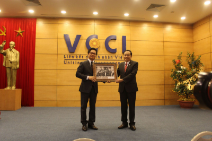Infrastructure investment will drive Vietnam's real estate growth
When Long Thanh International Airport opens its first phase in 2025, it will do more than move passengers. This massive project, designed to handle 100 million travellers and 5 million tonnes of cargo by 2035, is set to transform surrounding areas into thriving hubs for industry, retail, and residential spaces. Viet Nam’s commitment to infrastructure is visible in projects like Long Thanh, which open doors for the country’s property sector.
Long Thanh is just one part of a broader infrastructure drive. Viet Nam’s public investment of VND 657 trillion for 2024 signals a nationwide push to expand and modernise critical infrastructure, especially transport systems. These efforts are transforming connectivity, creating valuable real estate opportunities across the country, and laying a foundation for economic resilience.
Engine of Real Estate Growth
The Vietnamese government’s substantial investment in infrastructure reflects its goal to make key areas more accessible, reduce logistics costs, and spur growth in urban and suburban spaces. Prime Minister Pham Minh Chinh has emphasised the importance of removing administrative barriers and encouraging partnerships across public and private sectors to accelerate these developments. By prioritising infrastructure, the government is setting the stage for sustained real estate growth and unlocking the potential of key regions.
.jpg)
Long Thanh International Airport opens in 2025 and will serve 100 million passengers annually. Source: VGP
Key Projects Driving Demand
Long Thanh Airport, near Ho Chi Minh City, is on track to become a major Southeast Asian aviation hub. It is driving significant demand for residential properties in the surrounding areas. When it begins operations, real estate projects in its vicinity are expected to experience significant benefits. Developments such as those in Long Thanh town, Nhon Trach, and nearby parts of Dong Nai province will likely see increased demand due to improved accessibility and economic activity. Projects like SwanPark, SwanBay, and various residential and commercial complexes near key transport routes will particularly attract investors and residents looking for proximity to a major international hub, fostering both growth and higher property values.
In Ho Chi Minh City and Ha Noi, metro expansions, such as the Ben Thanh-Suoi Tien line, are transforming transit, boosting property values, and sparking new residential and commercial interest along their routes. Troy Griffiths, Deputy Managing Director at Savills Viet Nam, explains, “With every infrastructure upgrade, we strengthen the foundation for sustainable urban growth. Transit hubs like these anchor future residential and commercial demand, positioning surrounding areas as prime zones for long-term investment.”
Strategic roadways, including the North-South Expressway and Ring Roads in both cities, are reducing congestion, and linking economic hubs, attracting businesses and residents to suburban and regional developments. Ports like Lach Huyen Deep-Water Port and expressways in Quang Ninh are strengthening trade routes with China, increasing demand for industrial and logistics spaces near these key locations.

South Economic Zone Infrastructure. Source: Savills Viet Nam
Sector Impact
With 86 major infrastructure projects in progress, key developments highlighted here are directly impacting Viet Nam’s real estate sectors:
In industrial real estate, projects like the North-South Expressway attract high-value industries in electronics, semiconductors, and electric vehicles. With the “China Plus One” strategy encouraging diversification, Viet Nam’s enhanced logistics and transport routes make it a global manufacturing base. These upgrades streamline supply chains, while industrial zones near key infrastructure provide modern facilities and skilled labour, positioning Viet Nam as a leader in high-value manufacturing and logistics.
In office and retail, new metro lines and strategic roadways are opening up previously outlying areas for development, making them accessible and cost-effective alternatives to central business districts. Office hubs and retail spaces near transit lines and ring roads now attract companies and retailers aiming to balance convenience with operational costs. Marina Central Tower, directly connected to Ba Son Station on Metro Line No. 1 in Ho Chi Minh City, exemplifies this trend. As Viet Nam’s first transit-oriented development, it provides unmatched metro access, making it a prime location for both businesses and retail, capturing traffic from across the city.
For hospitality, infrastructure giants like Long Thanh Airport are a magnet for international and local travellers, driving demand for quality hotels. It is driving significant demand for residential properties in the surrounding areas. Recognising this potential surge, Gamuda has acquired the 18-hectare Dan Xuan project in Nhon Trach, highlighting the growing interest in housing and infrastructure to support the expected influx of residents and economic activity spurred by the airport’s completion.
Residential demand is also rising near these new transport links, especially in metro-connected areas where commutes are shorter and suburban living becomes viable. The government’s emphasis on accessible urban development aligns with these needs, making suburban areas increasingly attractive for families and professionals alike. Do Thi Thu Giang, Director of Advisory Services at Savills Viet Nam, highlights, “Infrastructure supports real estate development at all levels, particularly for residential projects. When transport links connect more communities, it enhances affordability and accessibility, positioning Viet Nam as a sustainable place for growth.”
.jpg)
Marina Central Tower, directly connected to Ba Son Station on Metro Line No. 1 in HCMC, is Viet Nam’s first transit-oriented development. Source: Masterise Homes
Long-Term Potential and Considerations
While infrastructure investment unlocks vast opportunities for Viet Nam’s real estate market, the long-term nature of these projects presents some risks. Large-scale developments require sustained funding and a stable regulatory framework to reach completion. Economic or political changes can affect timelines, impacting both infrastructure and real estate plans.
Despite these challenges, the government’s strategy to prioritise public-private investment partnerships lays a foundation for steady growth. As infrastructure projects roll out, Viet Nam’s real estate market is set to thrive, attracting both local and international investors looking for stable, long-term opportunities.
As these infrastructure projects progress, Viet Nam’s real estate landscape is shifting to meet the demands of a modern, connected economy. From new metro lines to expansive roadways and strategic hubs, these investments are drawing interest from local and global investors alike, each seeing the long-term value of a market built on accessibility and efficiency. As spaces transform, businesses grow, and new urban areas emerge, Viet Nam is not only building better infrastructure but is actively creating opportunities for resilient, forward-looking real estate development. This approach positions the country as a strong competitor in the regional property market, ready to capture the momentum of growth in Southeast Asia.








